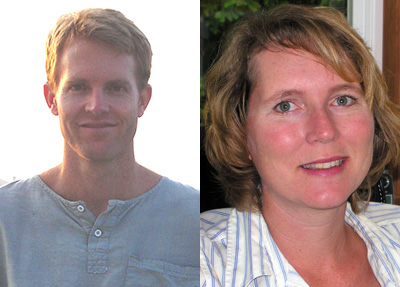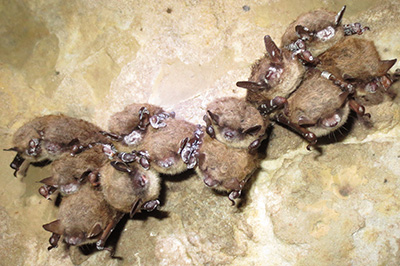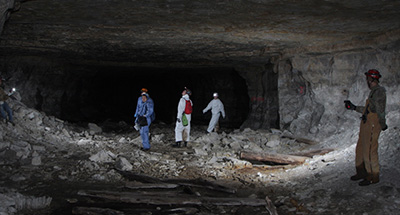A team led by scientists at UC Santa Cruz will conduct field trials this winter of two strategies for protecting bats from white-nose syndrome, a deadly fungal disease. The effort is funded by two grants, one from the U.S. Fish and Wildlife Service (USFWS) and another from Bat Conservation International and The Nature Conservancy. The UCSC team has also received two other grants from USFWS for studies of the ecology and epidemiology of the disease.
White-nose syndrome has devastated bat populations throughout eastern North America and continues to spread westward across the continent. Marm Kilpatrick and Winifred Frick in UCSC's Department of Ecology and Evolutionary Biology have been at the forefront of research on the disease, conducting field surveys to help track its spread and studying the dynamics of disease transmission and the impacts on bat populations.
Earlier this year, a study led by UCSC graduate student Joseph Hoyt showed that bacteria found naturally on some bats can inhibit the growth of the fungus that causes white-nose syndrome. After conducting additional tests of the bacteria on bats in the lab, the researchers wanted to see if applying it to bats in the wild can improve bats' chances of surviving the fungal infection.
"It's a small-scale field trial to test the efficacy of augmenting the amount of the bacteria that naturally occurs on the bats," said Frick.
Antifungal treatment
In addition, the researchers will test an antifungal product called chitosan, derived from the exoskeletons of insects and crustaceans. Kilpatrick said he offered to add a chitosan treatment arm to the planned field trial after seeing the results of laboratory tests conducted by Maarten Vonhoff at Western Michigan University. The trial will be conducted in an abandoned mine located at the leading edge of the spread of the disease.
"We've been monitoring the bats that hibernate in this mine, and the fungus first arrived there last year. Based on past experience, we anticipate that pretty much all of the bats will become infected when they return this year, with a mortality rate of 50 to 80 percent," Kilpatrick said. "If we can reduce the mortality rate to 30 percent or less, that could have a meaningful impact."
Frick and Kilpatrick are driven by a sense of urgency in the face of an epidemic that has decimated bat populations over large areas of North America. According to Kilpatrick, one species, the northern long-eared bat, appears to be headed for extinction, and the populations of several other species have crashed, declining by as much as 90 percent across large ranges.
"We need to act quickly and try to find solutions," said Frick.
Remnant populations
Another project funded by a USFWS grant will look at remnant populations of little brown bats in New York state, seeking to understand how a few populations have managed to stabilize after an initial crash. White-nose syndrome first emerged in upstate New York in 2006, and there are a handful of sites where populations of little brown bats initially declined by 75 percent but have since remained level or even increased slightly over the past few years. At most other sites populations have declined by more than 95 percent.
"If we can find the mechanism for how these populations are persisting we will have a better idea what their long-term prospects are," Frick said.
In a 2010 paper, Frick predicted that regional extinctions of little brown bats were likely within the next 16 years, but now she says their prospects look better. "I'm happy to be wrong about that, but we don't have a clear understanding of why some populations are persisting," she said.
A third project that also received funding will look at the disease dynamics of white-nose syndrome in a region outside North America where the fungus is endemic. The USFWS this week announced $2.5 million in grants for research on white-nose syndrome, including the UCSC grants.
Pest control
"Bats are a critical part of our ecology and provide essential pest control for our farmers, foresters and city residents, limiting the need to spray harmful pesticides," said USFWS director Dan Ashe. "As the disease continues its spread into new areas, it is more critical than ever that we continue our strong support for solid science to inform wise decisions about our natural resources."
Together with the BCI/TNC grant, the UC Santa Cruz team received a total of nearly $300,000 for the white-nose syndrome research program. Frick and Kilpatrick will be collaborating on these projects with researchers at the University of New Hampshire, University of Winnipeg, Harvard University, Northeast Normal University in China, University of Massachusetts, Amherst, and Arizona State University.






